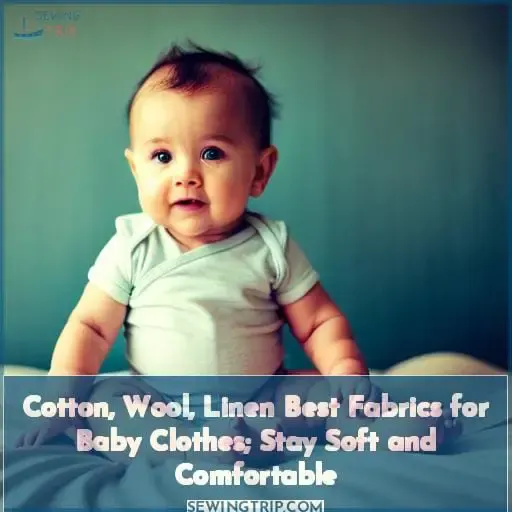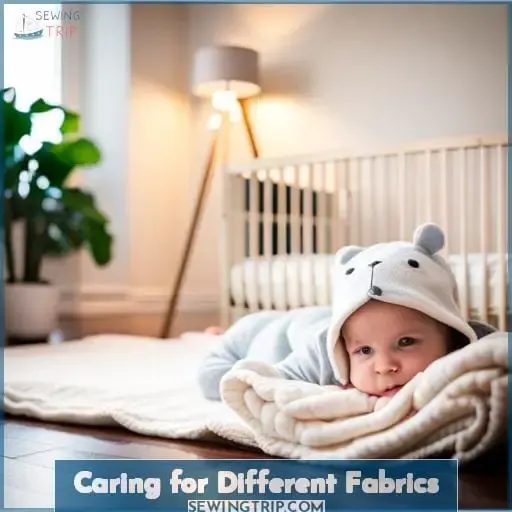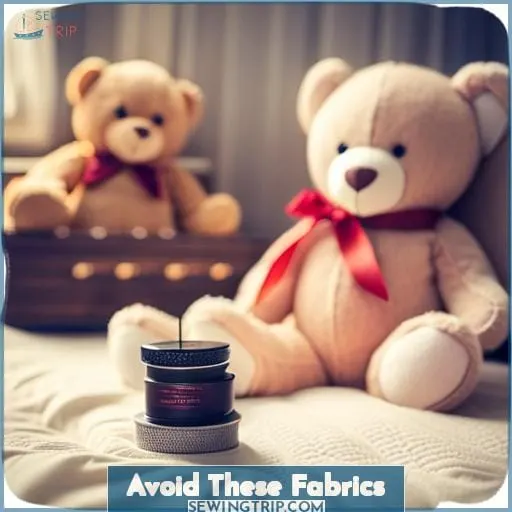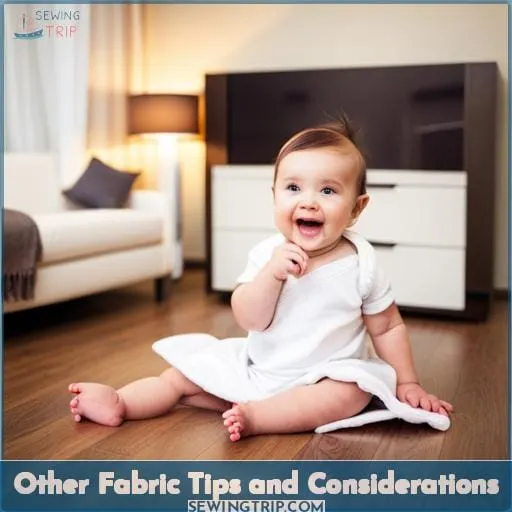This site is supported by our readers. We may earn a commission, at no cost to you, if you purchase through links.

In contrast, scratchy fabrics can cause discomfort and irritation, leading to fussy and restless behavior.
Understanding the various types of fabrics and their properties is crucial when selecting baby clothes.
Cotton, wool, and linen are natural fibers that are soft, breathable, and gentle on a baby’s delicate skin.
These fabrics allow for better air circulation, preventing overheating and ensuring a comfortable night’s sleep.
Learn more about these fabrics and how to care for them to keep your little one cozy and content.
Table Of Contents
Key Takeaways
- Cotton provides breathability, softness, and organic options but requires gentle washing.
- Wool regulates temperature yet may cause allergies, needing handwashing and air drying.
- Linen offers coolness and eco-friendly choices though combines best with other fabrics.
- Bamboo keeps skin cool and dry with thermo-regulating properties, however needs delicate handling.
Best Fabrics for Baby Clothes
When choosing fabrics for your baby’s clothes, you’ll want to select options that are soft, gentle, and comfortable against their delicate skin.
Fabrics like cotton, wool, linen, and bamboo check these boxes while also providing temperature regulation and absorbing moisture.
In the following sections, we’ll explore the benefits and drawbacks of these top fabric choices for keeping your little one comfy.
Cotton
Why is cotton one of the best fabrics for baby clothes?
You’re choosing it because:
- Cotton breathes wonderfully to keep sensitive skin comfy.
- Its softness prevents irritation on your little one’s delicate body.
Cotton’s breathability makes it ideal for babies.
Seek out lightweight weaves like voile or lawn that won’t overheat yet remain soft.
When possible, choose organic cotton for ultra-gentle comfort free of pesticide residues.
It’s available in ranges of weights to layer for seasonal comfort.
Wool
Use woolen fabrics for your baby’s clothes because wool regulates body temperature.
The natural fibers allow wool to adapt to changes in temperature, keeping your baby comfortable.
Be mindful of potential wool allergies.
Wash wool garments gently, using a wool-safe detergent.
Air dry to avoid shrinkage.
Wool offers temperature regulation that cotton can’t provide.
With proper care, wool is a smart choice for your baby’s wardrobe.
Linen
When choosing fabrics for your baby’s clothes, consider linen for its cool comfort during the warmer months.
Linen is valued for its breathable, lightweight weave that keeps babies dry.
This natural fiber offers stylish designs for your baby’s summer wardrobe.
Sewing with linen allows creative, eco-friendly choices to add to cotton and wool options.
Bamboo
While wearing bamboo material, baby’s skin will remain cool, comfortable, and dry.
Opt for this organic alternative offering breathable benefits in warm seasons.
Though requiring delicate handwashing, bamboo’s thermo-regulating and moisture-wicking properties make for stylish, soft choices against baby’s skin.
Combine with cotton, wool, or linen for the ultimate in comfortable, functional babywear.
Factors When Choosing Fabrics
When choosing fabrics for your baby’s clothes, prioritize:
- Comfort: Soft, gentle fabrics will prevent irritation.
- Durability: Durable fabrics withstand repeated washing.
- Easy care: Breathable, natural fabrics like cotton and linen keep your baby comfortable in any climate.
Comfort
All of your baby’s clothes should feel extraordinarily soft against their sensitive skin.
When choosing fabrics for baby clothes, prioritize comfort and softness.
Look for hypoallergenic options that won’t irritate their delicate skin.
Breathability is also important to ensure they stay cool and comfortable throughout the day.
Consider seasonal fabric choices to keep them cozy in winter or cool in summer.
Prewashing benefits cotton, wool, linen fabrics by making them even softer and more comfortable for your little one.
Durability
Your baby’s clothes should also be durable enough to withstand frequent washing and wearing without losing shape or becoming threadbare. Using fabrics that hold up well will prevent the need for constant clothing replacements.
Cotton offers good durability and abrasion resistance.
Wool resists pilling and retains its shape well.
Linen becomes softer but remains strong with washing and wearing.
Easy Care
When choosing fabrics for baby clothes, you’ll want to consider how easy they are to care for.
Cotton and linen are typically hassle-free when it comes to cleaning – they can easily be machine washed and dried.
Wool may require gentle hand washing or dry cleaning.
Overall, focus on fabrics that are low maintenance and save time on laundry.
Breathable natural fabrics like cotton, wool, and linen allow for hassle-free cleaning so you can keep baby’s clothes fresh.
Breathability
You’ll want to choose breathable fabrics that allow air to circulate and prevent overheating.
Go for lightweight cottons, linens, and bamboo in the summer.
Wool and fleece are better for colder months.
Seek out soft, natural fibers like organic cotton that won’t irritate baby’s skin.
Breathability ensures your little one stays cool and comfortable.
Caring for Different Fabrics
Hand-wash delicate cottons and linens using a gentle detergent.
Reshape while wet and lay flat to dry to prevent shrinkage.
For machine washing, use a gentle cycle with mild detergent on cool and tumble dry low to minimize agitation.
To clean wool, use a mild wool wash and limit soaking time.
Reshape wet wool items and lay flat to dry.
Machine Washing
Proper machine washing maintains fabrics’ softness and prevents shrinkage of baby clothes.
Choose a gentle, eco-friendly detergent and wash on a delicate cycle in cold water.
Lay flat or tumble dry on low.
For cotton, use bleach-free detergents.
Wool requires a no-agitate cycle and air drying.
Adding a stain pretreat prevents set-in stains.
Adjust washing routines seasonally for optimal fabric care.
Hand Washing
- You’ll gently wash your baby’s delicate clothes by hand with a mild detergent, following fabric care instructions for the perfect clean while retaining softness and shape.
- Use a mild detergent formulated for delicates.
- Fill a basin with cool water.
- Follow any special washing instructions.
- Soak clothes in water briefly, then swish gently.
Drying
You should air dry wool and linen baby clothes to prevent shrinkage, while cottons can go in the dryer on low heat.
Lay items flat or hang them to dry fully.
Avoid using fabric softeners and limit sunlight exposure which can damage fabrics.
Wool and linen will last longer when air dried.
For cottons, use low heat tumble drying and remove promptly before overdrying, then lay flat briefly to complete drying process.
Avoid These Fabrics
When choosing fabrics for your baby’s clothes, steer clear of synthetics like polyester and nylon.
These man-made fabrics don’t breathe well and can cause skin irritation, rashes, and overheating.
Stick to soft, natural fabrics like cotton and linen that feel good against your baby’s delicate skin.
Polyester
You avoid polyester in baby clothes as it can irritate sensitive skin.
Polyester risks allergies and skin irritation.
Seek eco-friendly, breathable alternatives like modern minky technology.
Use voile decoratively for older children.
Prioritize natural fibers like cotton, wool, and linen that stay soft against delicate skin with less environmental impact.
Nylon
After discussing polyester, you’d want to steer clear of nylon when choosing fabrics for baby clothes.
Like polyester, nylon tends to be less breathable and may irritate sensitive skin.
As another synthetic fabric, nylon carries risks like poor moisture absorption, flammability, and potential skin irritation for a baby’s delicate skin.
Focus on soft, breathable natural fabrics like cotton, wool, and linen instead.
Scratchy Fabrics
All scratchy fabrics irritate a baby’s sensitive skin, so don’t use them for any baby clothes touching their skin.
- Polyester: can cause fabric allergies and skin irritation, especially in newborns and young children.
- Nylon: not breathable and doesn’t absorb moisture well, leading to discomfort for the baby.
- Scratchy Fabrics: fabrics with rough textures or coarse fibers that can cause itching or irritation on delicate baby skin.
Stick to soft, comfortable fabrics like cotton, broderie anglaise, jersey knit, terry toweling, and muslin for your little one’s clothing needs.
Other Fabric Tips and Considerations
When selecting fabrics for your baby’s clothes:
- Prewash all materials before use to maximize softness and remove any residual chemicals.
- Consider organic cotton options for an eco-friendly choice that may be softer on sensitive skin.
- Depending on the season, look for lighter or warmer fabrics to keep your little one comfortable all year round.
Prewashing
When transitioning away from avoiding polyester, nylon, and scratchy fabrics onto other fabric considerations for baby clothes:
- Double check fabric care labels and prewash items prior to initial use.
- This removes potential irritants and ensures the material withstands washing prior to dressing your little one.
Employ a gentle wash cycle using a hypoallergenic detergent appropriate for the fabric type.
This precaution verifies fabric suitability while minimizing environmental impact through reduced water and energy consumption.
Organic Options
Since babies have sensitive skin, you should consider choosing organic cottons and wools if you want to avoid chemicals.
Opt for sustainable, eco-friendly alternatives like organic cotton, wool, hemp, and linen.
These natural fiber selections minimize irritation on a baby’s delicate skin while prioritizing comfort and safety.
Seek out responsible brands using green fabric options for babywear.
Seasonal Fabrics
You’ll also want to select your fabrics depending on the season and climate.
- Choose light, breathable summer linens for hot weather.
- Cozy up in wool knits when it’s cold out.
- Stick with soft, durable cotton options year-round.
- Bamboo blends provide cooling comfort all year.
Frequently Asked Questions (FAQs)
What fabrics should I avoid for baby clothes?
Avoid using synthetic fabrics like polyester for baby clothes.
They don’t breathe well and can irritate delicate skin.
Wool can also be rough and irritating.
Stick to soft, natural fabrics like cotton, bamboo, and linen that’ll keep your little one comfy.
How often should I wash baby clothes?
Wash baby clothes before first use and as needed when visibly soiled or smelly.
Check clothing labels.
Gently wash most items after each wearing.
Air dry when possible.
Are there any safety concerns with certain fabric dyes or prints?
Certain dyes and prints may contain harmful chemicals.
Carefully check fabric composition and safety certifications before use, especially for clothes touching baby’s skin.
Prioritize trusted organic materials over aesthetics.
Baby’s health comes first.
What’s the best way to wash and dry baby clothes?
Gently machine wash baby clothes in cold water with a mild detergent.
Use the gentle cycle setting and avoid using fabric softeners or bleach.
Line dry or tumble dry on low when possible.
These precautions help maintain softness and prevent shrinkage.
Handle with care.
Where can I buy affordable, high-quality baby clothes?
Visit trusted online baby boutiques for quality, affordable clothes.
Check customer reviews and return policies before purchasing.
Local consignment shops may also offer gently used items at reduced prices.
Focus on comfort and safety first when choosing baby clothes.
Conclusion
When dressing your little bundle of joy, prioritize their comfort above all else.
Choose soft, breathable natural fabrics like cotton, wool, and linen that gently hug their skin.
Handle these fabrics with care, washing on delicate and line drying when possible, so they remain plush and cozy for years.
Though convenience may tempt you, avoid synthetic fabrics; the best fabric for baby clothes is always natural.
Your child’s contentment rests on that soft onesie, so pick it as you’d their blanket—for ultimate comfort.











